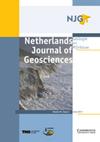诱发地震活动和地震风险管理——来自Californië地热田的展示(荷兰)
IF 2.3
2区 地球科学
Q3 GEOSCIENCES, MULTIDISCIPLINARY
Netherlands Journal of Geosciences-Geologie En Mijnbouw
Pub Date : 2022-07-19
DOI:10.1017/njg.2022.12
引用次数: 2
摘要
摘要:在荷兰Venlo附近的Californië地热田,运行了两个紧密间隔的地热双重层。地热井目标为深度2 km以下的地田Zeeland组。几年来,泰格伦断层(Roer Valley裂谷系统中的一个区域断层)产生了热流体,直到一场感觉强烈的1.7级地震导致地热活动暂停。Californië展示为地热项目的诱发地震活动风险的评估和管理提供了一个难得的机会。在项目的几个阶段进行了地震危险性评估,并通过本地台站网络连续监测地震活动。在本文中,我们报告了诱发地震活动的特征,并评价了地震前进行的地震危险性评估的结果。地震危险性评估是基于与地热作业相关的地下应力变化的数值模拟。地质力学分析表明,图中断层在地下可能处于临界应力状态。据推测,最大的危险来自于热弹性应力,起源于靠近Tegelen断层的冷水注入。随后的地震主要发生在停产或减产后的生产井附近。我们将这一观察结果归因于Tegelen断层附近冷水注入引起的热弹性应力负荷,以及生产过程中压力耗尽导致的断层反作用稳定。这一机制与之前地震危险性评估中考虑的主导机制一致。虽然地热作业尚未恢复,但地质力学分析表明,将其中一口注入井重新定位在远离Tegelen断层的地方,可以为减轻Californië诱发地震活动的风险提供有效措施。本文章由计算机程序翻译,如有差异,请以英文原文为准。
Induced seismicity and seismic risk management – a showcase from the Californië geothermal field (the Netherlands)
Abstract Two closely spaced geothermal doublets were operated in the Californië geothermal field near Venlo, the Netherlands. The geothermal wells target the Dinantian Zeeland formation below 2 km depth. For several years, hot fluid was produced from the Tegelen fault, a regional fault in the Roer Valley rift system, until a felt M1.7 earthquake led to the suspension of geothermal activities. The Californië showcase provides a rare opportunity to retrospectively evaluate the assessment and the management of induced seismicity risks for a geothermal project. A seismic hazard assessment was conducted at several stages of the project, and seismicity was continuously monitored with a local station network. In this paper, we report on the characteristics of the induced seismicity and evaluate the findings of the seismic hazard assessments conducted prior to the earthquakes. Seismic hazard assessments were based on numerical simulations of subsurface stress changes associated with geothermal operations. A geomechanical analysis indicated that the mapped faults in the subsurface are likely to be critically stressed. The largest hazard was inferred to result from thermo-elastic stresses, originating from cold water injection close to the Tegelen fault. Subsequent earthquakes predominantly occurred near a production well after stopping or reducing production. We attributed this observation to a thermo-elastic stress load caused by cold water injection close to the Tegelen fault, combined with a counter-acting stabilisation of the fault due to pressure depletion during production. This mechanism was consistent with the dominating mechanism considered in the preceeding seismic hazard assessments. Although geothermal operations have not resumed yet, the geomechanical analysis indicates that re-locating one of the injection wells further away from the Tegelen fault could provide an efficient measure for mitigating induced seismicity risks at Californië.
求助全文
通过发布文献求助,成功后即可免费获取论文全文。
去求助
来源期刊
CiteScore
4.00
自引率
25.90%
发文量
14
审稿时长
>12 weeks
期刊介绍:
Netherlands Journal of Geosciences - Geologie en Mijnbouw is a fully open access journal which publishes papers on all aspects of geoscience, providing they are of international interest and quality. As the official publication of the ''Netherlands Journal of Geosciences'' Foundation the journal publishes new and significant research in geosciences with a regional focus on the Netherlands, the North Sea region and relevant adjacent areas. A wide range of topics within the geosciences are covered in the journal, including "geology, physical geography, geophyics, (geo-)archeology, paleontology, hydro(geo)logy, hydrocarbon exploration, modelling and visualisation."
The journal is a continuation of Geologie and Mijnbouw (published by the Royal Geological and Mining Society of the Netherlands, KNGMG) and Mededelingen Nederlands Instituut voor Toegepaste Geowetenschappen (published by TNO Geological Survey of the Netherlands). The journal is published in full colour.

 求助内容:
求助内容: 应助结果提醒方式:
应助结果提醒方式:


